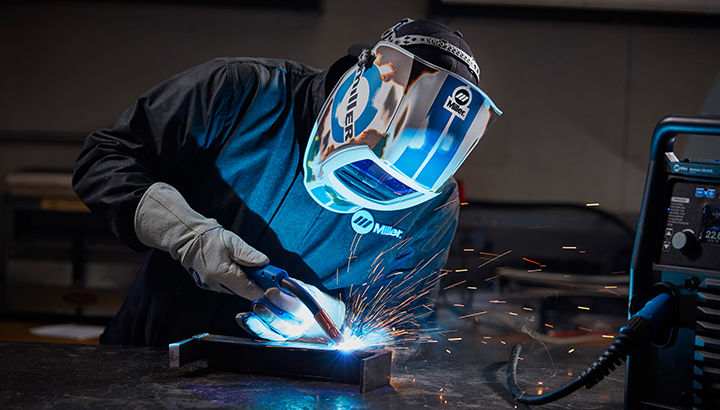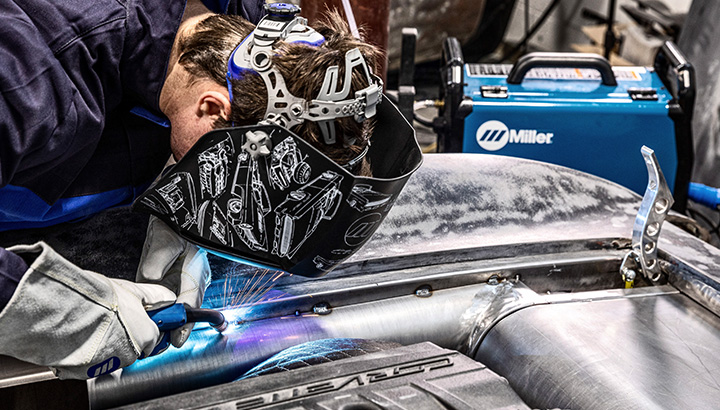Typical Welding Repair Work Issues and Just How to Address Them Effectively
Welding repair work usually run into a series of concerns that can endanger the stability of the last product. Typical problems include insufficient penetration, porosity, and misalignment, to name a few. Each issue presents distinct difficulties that need particular techniques for resolution. Understanding these issues is important for welders aiming to boost their skills and end results. This conversation will explore these common welding repair service problems and effective approaches to resolve them.
Poor Penetration
Insufficient infiltration occurs when the weld metal falls short to completely fuse with the base product, leading to weak joints and prospective architectural failings. This problem usually originates from not enough heat input, inaccurate electrode angle, or incorrect welding rate. Welders might experience inadequate infiltration because of a miscalculation of the needed specifications for a details material density or type. Furthermore, contamination on the base product's surface area can prevent reliable bonding, exacerbating the problem. To deal with poor infiltration, welders should assure appropriate settings on their equipment and preserve a clean work surface. Routine inspection of welds is suggested to recognize any type of shortages early, permitting prompt adjustments and the prevention of compromised architectural integrity in welded assemblies.
Porosity
Porosity is an usual issue in welded joints that shows up as little gas bubbles trapped within the weld metal. This flaw can compromise the stability of the weld, bring about decreased toughness and possible failing under anxiety. Montana Mobile Welding and Repair Fabrication. Porosity typically develops from contamination, wetness, or inappropriate welding methods, which permit gases to leave right into the liquified weld swimming pool. To attend to porosity, welders should assure appropriate surface prep work, maintain a clean working environment, and use suitable welding criteria. Additionally, picking the appropriate filler material and securing gas can reduce gas entrapment. Normal evaluation and screening of welds can aid determine porosity early, guaranteeing timely restorative activities are taken, thereby maintaining the quality and dependability of the bonded framework
Misalignment
Misalignment in welding can occur from various variables, including inappropriate configuration and thermal growth. Comprehending the origin is essential for efficient resolution. Several improvement techniques are available to straighten elements and assure architectural integrity.
Reasons for Misalignment
Welding misalignment often originates from a variety of underlying problems that can endanger structural integrity. One main cause is inappropriate fit-up of parts before welding, which can bring about spaces and unequal surfaces. Variations in thermal development throughout the welding process can likewise result in distortion, especially if the products being signed up with have various coefficients of expansion. Additionally, inadequate fixturing and clamping may fail to hold elements safely in area, causing movement during welding. Badly conserved devices, consisting of welding makers and devices, may present disparities in the weld bead, more adding to misalignment. Lastly, driver mistake, coming from inadequate training or experience, can additionally play a substantial role in developing misaligned welds.
Improvement Techniques Available
Addressing misalignment properly needs a combination of rehabilitative methods customized to the certain concerns available. One usual method is using components or jigs to hold elements in the proper placement during welding, making certain constant placement. In addition, pre-heating the materials can help in reducing distortion and improve fit-up. For substantial misalignment, mechanical realignment methods, such as using hydraulic jacks or clamps, can be employed to remedy the placement prior to welding. Post-weld warm treatment might also be essential to soothe tensions triggered by misalignment. Ultimately, careful inspection and modification during the configuration phase can prevent misalignment problems from coming to be significant troubles, promoting a smoother welding procedure and boosting general architectural stability.
Distortion
Distortion is a typical difficulty in welding that can emerge from different aspects, including irregular heating & cooling. Recognizing the root causes of distortion is vital for carrying out effective avoidance strategies. Resolving this concern not only boosts architectural stability however likewise improves the general top quality of the weld.
Root causes of Distortion
When based on the extreme warmth of welding, materials frequently undergo modifications that can result in distortion. This sensation mostly emerges from thermal development and contraction throughout the welding process. As the weld area heats up, the product broadens; upon cooling, it gets, which can develop inner anxieties. Additionally, unequal home heating across a work surface can intensify these stresses, leading to bending or bending. The kind of product additionally plays a considerable this content duty; metals with varying thermal conductivity and coefficients of development may respond differently, causing unforeseeable distortions. Inadequate joint layout and inadequate fixturing can add to misalignment throughout welding, raising the probability of distortion. Recognizing these causes is necessary for effective welding repair service and prevention strategies.
Avoidance Techniques
Reliable prevention techniques for distortion during welding concentrate on managing warm input and making sure correct joint layout. Preserving a regular warm input assists to minimize thermal development and contraction, which can cause distortion. Using strategies such as pre-heating the workpiece can additionally decrease the temperature slope, advertising consistent home heating. In addition, choosing suitable joint designs, such as T-joints or lap joints, can boost stability and minimize anxiety focus. Carrying out correct fixturing to protect the workpieces in location better aids in keeping alignment throughout the welding procedure. Ultimately, staggered welding sequences can distribute warmth more evenly, avoiding local distortion. By using these approaches, welders can substantially reduce the possibility of distortion and enhance the overall quality of their welds.
Splitting
Splitting is a typical issue encountered in welding repair services, typically resulting from different aspects such as inappropriate air conditioning rates, material option, or insufficient joint preparation. The incident of fractures can considerably jeopardize the honesty of the weld, leading to prospective failings during operation. To resolve this problem, welders should first examine the origin creates, making sure that materials work and appropriately chosen for the specific application. In addition, controlling the air conditioning rate throughout the welding process is necessary; rapid cooling can induce anxiety and bring about breaking. Correct joint design and preparation additionally contribute to decreasing the risk. Executing these strategies can improve weld top quality and toughness, ultimately reducing the possibility of fracturing in finished weldments.

Insufficient Blend
A substantial concern in welding repair laser welder for sale work is insufficient fusion, which happens when the weld steel does not appropriately bond with the base material or previous weld passes - Montana Mobile Welding and Repair Belgrade Fabrication. This issue can cause weak points in the joint, potentially jeopardizing the honesty of the bonded framework. Variables adding to incomplete combination consist of not enough warm input, incorrect welding technique, and contamination of the surface areas being joined. To resolve this issue efficiently, welders must assure proper pre-weld cleaning and surface area preparation, in addition to adjust their welding criteria to attain sufficient infiltration and blend. Routine examination throughout the welding process can additionally help recognize insufficient blend early, allowing for prompt corrective actions to boost the total quality of the weld
Overheating
While welding repair services can improve architectural stability, overheating presents a substantial obstacle that can bring about material destruction. Extreme warm during welding can change the mechanical buildings of steels, leading to decreased stamina, increased brittleness, and bending. This sensation is specifically critical in high-stress applications where architectural integrity is critical. Determining getting too hot can include visual inspections for discoloration or distortion, along with keeping track of temperature level during the welding procedure. To alleviate the risks linked with getting too hot, welders ought to utilize proper strategies, such as regulating heat input, changing travel speed, and utilizing appropriate filler materials. In addition, implementing pre- and post-weld heat treatments can aid recover product residential properties and boost the general top quality of the repair work, guaranteeing lasting performance and safety and security.
Often Asked Inquiries
What Are the Common Indicators of a Welding Flaw?

Exactly How Can I Check My Welds for Top quality?
To check welds for high quality, one can use aesthetic examinations, ultrasonic screening, and radiographic methods. Each technique guarantees structural integrity, identifies flaws, and validates adherence to defined requirements, inevitably enhancing the reliability of the bonded joints.
What Safety and security Safety Measures Should I Take While Welding?
When welding, one ought to prioritize safety by wearing appropriate individual safety equipment, making sure correct air flow, protecting flammable products away, keeping a clean work area, and understanding surroundings to prevent injuries and accidents.
Can I Repair a Weld Without Renovating the Entire Joint?
Fixing a weld without redesigning the entire joint is possible, relying on the damage (Montana Mobile Welding and Repair Belgrade Welding). Methods such as grinding, adding filler product, or making use of a welding procedure can efficiently resolve details defects while protecting the surrounding structure
What Equipment Are Vital for Efficient Welding Fixes?
Crucial devices for efficient welding repairs include a welding machine, cord brush, grinder, safety gear, clamps, and filler materials. Each device plays a crucial role in guaranteeing top quality and safety during the fixing procedure. Porosity generally develops from contamination, moisture, or inappropriate welding techniques, which enable gases to escape right into the molten weld swimming pool. Inadequately kept tools, including welding devices and devices, might present inconsistencies in the weld bead, more adding to misalignment. When subjected to the extreme warm of welding, products commonly undergo modifications that can lead to distortion. Splitting is an usual issue encountered in welding fixings, frequently resulting from different factors such as incorrect air conditioning rates, material choice, or inadequate joint preparation. A substantial concern in welding repairs is incomplete fusion, which occurs when the weld steel does not properly bond plastic staple welder with the base material or previous weld passes.